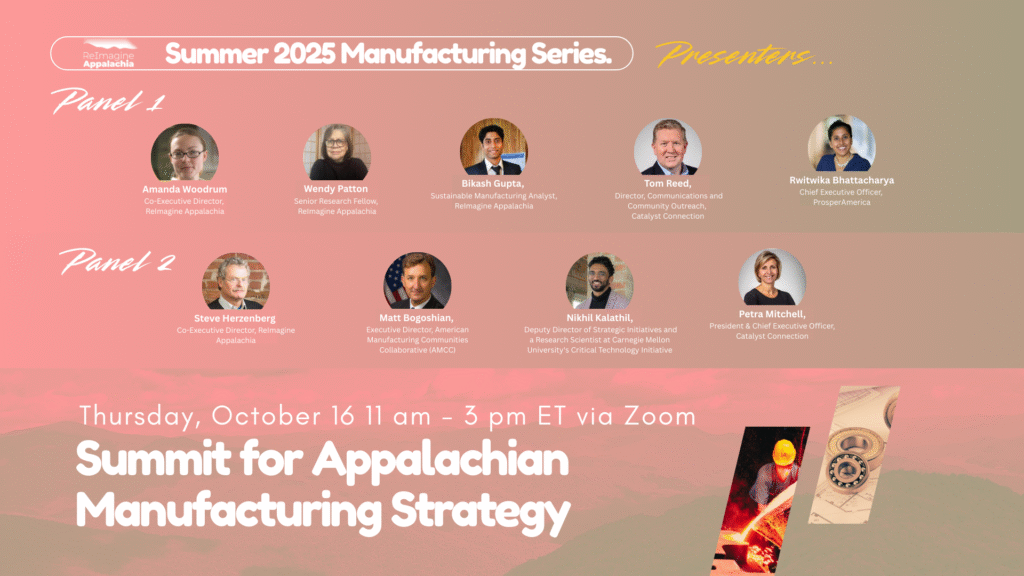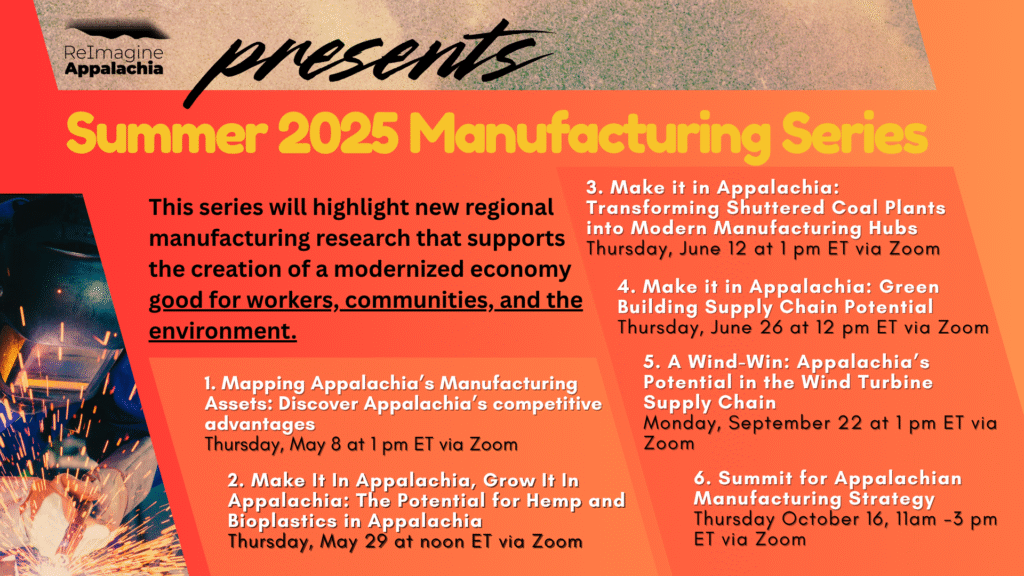Thursday, October 16 at 11 am -3 pm ET via Zoom

Thursday, October 16 at 11 am -3 pm ET via Zoom – The culmination of our manufacturing summer series, the Appalachian Manufacturing Action Plan Summit will be a chance to discuss the future of manufacturing in our region and the path to get there. The three hour event will include a variety of sessions to choose from on a range of topics and a larger conversation based around the creation of ReImagine Appalachia’s new Manufacturing Action Plan.
EVENT AGENDA
11:00 – 11:55 – Full Group Session – Panel 1
Driving a Collective Vision: Transforming Appalachia into a Hub for Sustainable Manufacturing
Description: At this opening session focused on Appalachia’s manufacturing potential, ReImagine Appalachia will introduce their new Manufacturing Action Plan aimed at accelerating growth in the region’s manufacturing sectors. A presentation on ReImagine’s interactive manufacturing strengths storymap, funding opportunities, and job creation at the intersection between various partners and philanthropic groups will provide specific examples on regional strengths and areas for growth.
Speakers:
- Amanda Woodrum, Co-Executive Director, ReImagine Appalachia
- Wendy Patton, Senior Research Fellow, ReImagine Appalachia
- Bikash Gupta, Sustainable Manufacturing Analyst, ReImagine Appalachia
- Tom Reed, Director, Communications and Community Outreach, Catalyst Connection
- Rwitwika Bhattacharya, Chief Executive Officer, Prosper America
12:00 – 12:45 – Breakout Session Round 1
These five breakout sessions will occur simultaneously. Participants will be shown how to choose their breakout room in zoom during the event. If you arrive late, you can join a session in progress.
1a: Make it in Appalachia: Appalachia’s historic strengths in manufacturing as well as its central location make it uniquely suited to become a manufacturing hub for the country. Join this breakout session to discuss the sectors ranging from building materials to wind turbine parts that hold promise for the region’s future.
2a: Buy it in Appalachia: Appalachia has the capacity to manufacture a wide range of essential products, and the region should be using these locally-produced goods as well! In this breakout session, we will discuss how regional procurement policies can support prosperity in regional manufacturing and generate other cost-saving and sustainability benefits at the same time.
3a: Grow it in Appalachia: The Appalachian region is well suited to growing a number of high demand bio-based feedstocks that can be used to manufacture the sustainable products of the future. Take part in this conversation around promising crops like industrial hemp and the barriers that must be overcome to unlock the full potential of the bio-based manufacturing sector.
4a: Reuse It in Appalachia: As Appalachian communities work to redevelop vacant sites like shuttered coal plants or reimagine existing industrial operations, reuse and circular manufacturing will help increase regional sustainability, prosperity, and competitiveness for the future. Join experts from groups already engaging with reuse around the region to discuss how circular manufacturing can be further implemented through projects like waste collection systems, eco-industrial park models, and more.
5a: Work in Appalachia: Time and time again, Appalachia’s skilled workforce has been identified as one of its greatest strengths. In this breakout session, we will discuss how to ensure that Appalachian workers receive the fair compensation they deserve in new manufacturing jobs.
12:45 – 1:45 – Full Group Session – Panel 2
Getting from here to there: Developing an Appalachian Manufacturing Action Plan
Description: This full group session will build on the opening session to further explore the details of exactly how Appalachia can realize its manufacturing potential and transition into the role of a regional manufacturing hub. Key speakers will share examples from their work to inspire discussions that lead to the actionable steps needed to bring the vision closer to reality.
Speakers:
- Steve Herzenberg, Co-Executive Director, ReImagine Appalachia
- Matt Bogoshian, Executive Director, American Manufacturing Communities Collaborative (AMCC)
- Nikhil Kalathil, Deputy Director of Strategic Initiatives and a Research Scientist at Carnegie Mellon University’s Critical Technology Initiative & Senior Advisor for Ecosystem Assessment for the American Manufacturing Communities Collaborative (AMCC)
- Petra Mitchell, President & Chief Executive Officer, Catalyst Connection
1:45 – 2:45 – Breakout Session Round 2
These five breakout sessions will occur simultaneously. Participants will be shown how to choose their breakout room in zoom during the event. If you arrive late, you can join a session in progress.
1b: Make it in Appalachia continued: We know Appalachia has manufacturing strengths, but in this session we invite participants to share their thoughts on how exactly these strengths can be leveraged and turned into tangible new opportunities.
2b: Invest in Appalachia: Appalachia is ripe for private investments – with its assets and skilled workforce from the coal industry that can pivot towards the new energy economy, rare earth elements and critical minerals that can be mined from coal ash ponds and acid mine drainage, and carbon-friendly rail and waterway transportation systems. Join this breakout session to help tell the region’s story to potential investors.
3b: Decarbonize Appalachian Industry: the Ohio River Valley was the heart of the industrial revolution and still maintains significant manufacturing strength compared to the rest of the nation. How do we help ensure the region’s industry can thrive in the new clean economy, maintaining its global competitiveness by reducing its carbon footprint (and creating good jobs in the process)
4b: Redevelop it in Appalachia: Some of the most significant assets in coal communities are shuttered coal-fired power plants, which once served as the region’s primary source of good jobs and the foundation for the local tax base. This session will focus on how, with suitable investments, shuttered and shuttering coal plants can be redeveloped for new opportunities in the sustainable industries of the future.
5b: Who Owns It?: In this breakout session, we discuss- who owns the land and how do you access it? The trend of absentee land ownership, combined with complicated land policy, divided ownership and lack of accurate records can be a barrier to new development, particularly on former mine sites or brownfield sites. This session will discuss these dynamics, new resources to track and map land ownership, and future strategies to address this centuries old dynamic.
2:45 – 3:00 – Closing Full Group Session & Remarks
MORE ON THE SERIES…

This event is part of our Summer 2025 Manufacturing Series, an ongoing series of events sharing new research on opportunities within Appalachia’s manufacturing sector, from growing feedstocks to producing final products. This series of listening sessions will explore the specific opportunities to leverage the region’s historical assets for the new energy economy and create a hub for sustainable manufacturing. Appalachians should have a say in the work to keep opportunities in the region and support the creation of a 21st century economy that’s good for workers, communities, and the environment.
